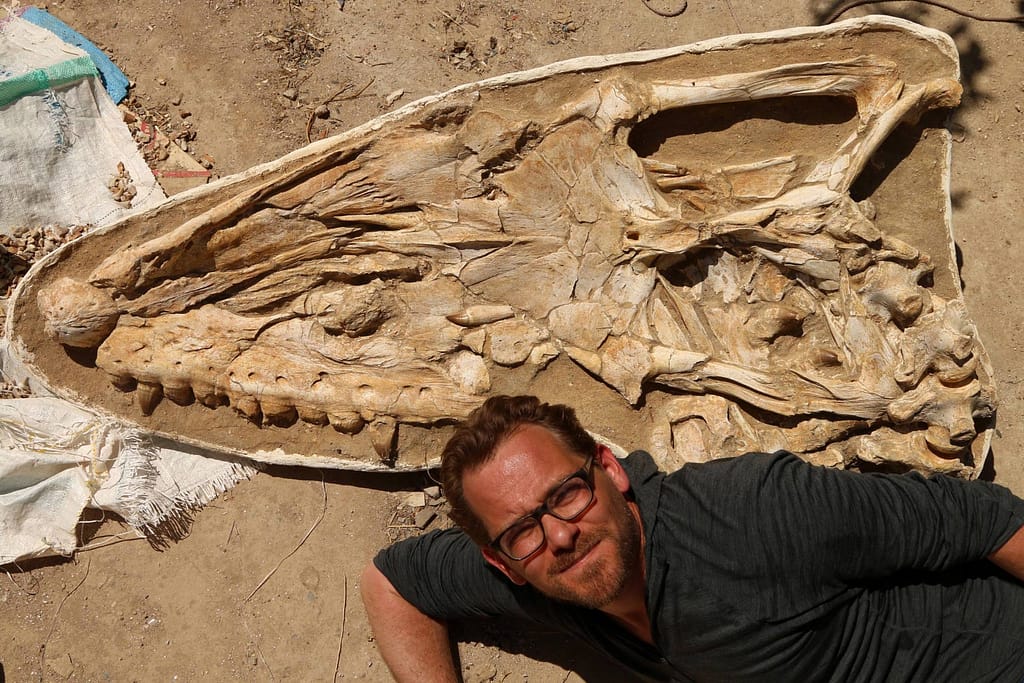
Dr. Nick Longrich with the Thalassotitan atrox fossil. Image credit: Nick Longrich.
Unveiling the Mosasaur Dynasty
Mosasaur, belonging to the family Mosasauridae, were a group of lizards that underwent significant specialization for life in marine environments during the Cretaceous era. Their highest diversity was observed during the Maastrichtian age, occurring between 72 and 66 million years ago, with Morocco housing some of the most diverse mosasaur faunas.
Adaptive Diversification and Ecological Niches
By the end of the Cretaceous period, mosasaurs had undergone adaptive diversification, resulting in a wide range of body sizes, locomotion styles, and dietary preferences. While some mosasaurs evolved to consume small prey like fish and squid, others developed crushing abilities to feed on ammonites and clams.
Introducing Thalassotitan atrox
Thalassotitan atrox, a newly identified mosasaur species, emerged as a top predator, preying on other marine reptiles. With a massive skull measuring 1.4 meters (5 feet) in length and reaching a total length of nearly 9 meters (30 feet), this marine giant equaled the size of a killer whale.
Unique Adaptations of Thalassotitan atrox:
Unlike most mosasaurs with elongated jaws and slender teeth suited for catching fish, Thalassotitan atrox possessed a short, wide muzzle and robust conical teeth resembling those of an orca. These adaptations allowed it to grasp and tear apart substantial prey. The combination of features suggests Thalassotitan atrox occupied the apex predator position, reigning at the top of the marine food chain.
Unveiling Fossil Evidence
The remains of Thalassotitan atrox were discovered in the phosphatic beds of the Oulad Abdoun Basin in Khouribga Province, Morocco. Notably, the teeth of Thalassotitan atrox exhibit signs of
heavy wear and breakage, inconsistent with a diet of fish. These observations suggest that the mosasaur targeted other marine reptiles, using its teeth to bite into their bones and tear them apart. Fossils from the same site reveal acid damage, indicating that Thalassotitan atrox likely digested its prey, leaving behind the bones.
The Flourishing of Mosasaurs
The recent findings of mosasaurs in Morocco, including Thalassotitan atrox, challenge the notion that mosasaurs were in decline before the asteroid impact responsible for the end-Cretaceous mass extinction. Instead, these discoveries suggest that mosasaurs thrived and diversified in the late Cretaceous. The phosphate fossils found in Morocco provide an exceptional glimpse into the paleobiodiversity during this critical period.
Conclusion
Thalassotitan atrox, an awe-inspiring marine predator from the Cretaceous oceans, exemplifies the remarkable adaptations and diversification of mosasaurs. Its short, robust muzzle and powerful teeth distinguish it as a fearsome apex predator, while fossil evidence hints at its diet and the digestive process. These findings shed light on the flourishing mosasaur populations before the catastrophic events that marked the end of the Cretaceous era. The rich phosphate deposits in Morocco continue to unveil the fascinating story of ancient seas, providing invaluable insights into the evolutionary history of marine life. Further research and discoveries in this field will undoubtedly enhance our understanding of the past and contribute to our knowledge of the Earth’s diverse ecosystems.



